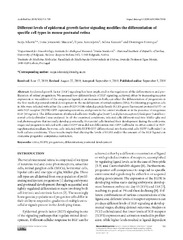Приказ основних података о документу
Different levels of epidermal growth factor signaling modifies the differentiation of specific cell types in mouse postnatal retina
| dc.creator | Ivković, Sanja | |
| dc.creator | Jovanović Macura, Irena | |
| dc.creator | Antonijević, Tijana | |
| dc.creator | Kanazir, Selma | |
| dc.creator | Henrique, Domingos | |
| dc.date.accessioned | 2020-04-27T10:19:45Z | |
| dc.date.available | 2020-04-27T10:19:45Z | |
| dc.date.issued | 2019 | |
| dc.identifier.issn | 0354-4664 | |
| dc.identifier.uri | http://www.serbiosoc.org.rs/arch/index.php/abs/article/view/4389 | |
| dc.identifier.uri | https://radar.ibiss.bg.ac.rs/handle/123456789/3648 | |
| dc.description.abstract | Epidermal growth factor (EGF) signaling has been implicated in the regulation of the differentiation and proliferation of retinal progenitors. We assessed how different levels of EGF signaling, achieved either by increasing receptor expression or via addition of the exogenous ligand, or an increase in both, can affect the differentiation of progenitors in the first week of postnatal retinal development in the model system of retinal explants (REs). Proliferating progenitor cells in REs were infected with either the control CLV3/ESR-related peptide family (CLE)-green fluorescent protein (GFP)-or with EGF receptor (EGFR)-GFP-expressing retrovirus, and grown in the control medium or in the presence of exogenous EGF (10 ng/mL). The differentiation of infected cells into Muller glia (Sox9+), rod photoreceptors (rhodopsin+) and horizontal cells (calbindin+) was analyzed. In all the examined conditions, infected cells differentiated into Muller glia and rod photoreceptors that normally develop postnatally. Horizontal cells finished their development during the embryonic stages and progenitors infected with control-GFP virus did not differentiate into GFP+/calbindin-in either control or EGFsupplemented medium, however, cells infected with EGFR-GFP differentiated into horizontal cells (GFP+/calbindin+) in both culture conditions. These results imply that altering the levels of EGFR and/or the amount of the EGF ligand can overcome progenitor competence restriction. | en |
| dc.relation | Marie Curie Welcome II fellowship | |
| dc.relation | Portuguese Foundation for Science and Technology | |
| dc.rights | openAccess | |
| dc.rights.uri | https://creativecommons.org/licenses/by-nc-nd/4.0/ | |
| dc.source | Archives of Biological Sciences | |
| dc.subject | EGFR | |
| dc.subject | Differentiation | |
| dc.subject | Postnatal development | |
| dc.subject | Progenitors | |
| dc.subject | Retina | |
| dc.title | Different levels of epidermal growth factor signaling modifies the differentiation of specific cell types in mouse postnatal retina | en |
| dc.type | article | en |
| dc.rights.license | BY-NC-ND | |
| dcterms.abstract | Хенриqуе, Домингос; Јовановић Мацура, Ирена; Aнтонијевић, Тијана; Каназир, Селма; Ивковић, Сања; | |
| dc.rights.holder | © 2019 by the Serbian Biological Society. | |
| dc.citation.issue | 4 | |
| dc.citation.volume | 71 | |
| dc.identifier.doi | 10.2298/abs190617054i | |
| dc.identifier.scopus | 2-s2.0-85083196497 | |
| dc.identifier.wos | 000505766800015 | |
| dc.citation.apa | Ivković, S., Jovanović-Macura, I., Antonijević, T., Kanazir, S., & Henrique, D. (2019). Different levels of epidermal growth factor signaling modifies the differentiation of specific cell types in mouse postnatal retina. Archives of Biological Sciences, 71(4), 711–719. | |
| dc.citation.vancouver | Ivković S, Jovanović-Macura I, Antonijević T, Kanazir S, Henrique D. Different levels of epidermal growth factor signaling modifies the differentiation of specific cell types in mouse postnatal retina. Arch Biol Sci. 2019;71(4):711–9. | |
| dc.citation.spage | 711 | |
| dc.citation.epage | 719 | |
| dc.type.version | publishedVersion | |
| dc.identifier.fulltext | https://radar.ibiss.bg.ac.rs/bitstream/id/6120/ABS-71-4-711-719.pdf | |
| dc.citation.rank | M23 |

